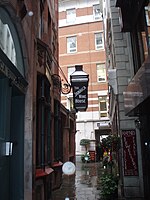
Samuel Pepys was an English diarist and naval administrator. He served as administrator of the Royal Navy and Member of Parliament and is most famous for the diary he kept for a decade. Pepys had no maritime experience, but he rose to be the Chief Secretary to the Admiralty under both King Charles II and King James II through patronage, diligence, and his talent for administration. His influence and reforms at the Admiralty were important in the early professionalisation of the Royal Navy.
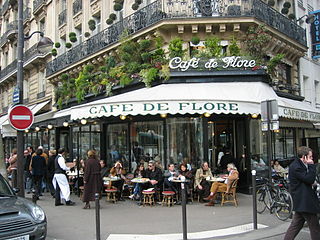
A coffeehouse, coffee shop, or café is an establishment that primarily serves various types of coffee, notably espresso, latte, and cappuccino. Some coffeehouses may serve cold drinks, such as iced coffee and iced tea, as well as other non-caffeinated beverages. A coffeehouse may also serve food, such as light snacks, sandwiches, muffins, fruit, or pastries. In continental Europe, some cafés also serve alcoholic beverages. Coffeehouses range from owner-operated small businesses to large multinational corporations. Some coffeehouse chains operate on a franchise business model, with numerous branches across various countries around the world.

Ludgate Hill is a street and surrounding area, on a small hill in the City of London, England. The street passes through the former site of Ludgate, a city gate that was demolished – along with a gaol attached to it – in 1760.

Sir William Penn was an English admiral and politician who sat in the House of Commons from 1660 to 1670. He was the father of William Penn, founder of the colonial Province of Pennsylvania, which is now Pennsylvania.

Cornhill is a ward and street in the City of London, the historic nucleus and financial centre of modern London, England. The street runs between Bank Junction and Leadenhall Street.

Jonathan's Coffee House was a significant meeting place in London in the 17th and 18th centuries, famous as the original site of the London Stock Exchange.
Will's Coffee House was one of the foremost coffeehouses in England in the decades after the Restoration. It was situated in Russell Street in London, at the northwest corner of Bow Street, between the City and Westminster. According to the Methuen Drama Dictionary of the Theatre, it was also known as the Rose Tavern, the Russell Street Coffee House, and the Wits' Coffee House. It was founded by Will Urwin.
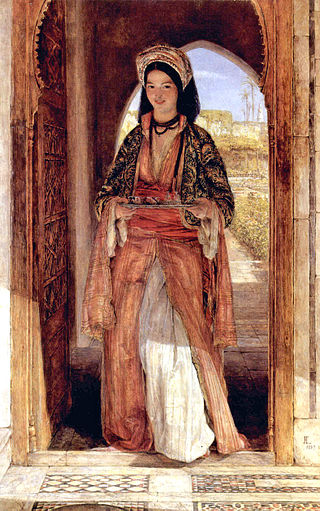
The history of coffee dates back to centuries of old oral tradition in modern day Jimma, Ethiopia. Coffee was first cultivated in Yemen, then later introduced to other countries. In the 15th century, Sufi monasteries in Yemen employed coffee as an aid to concentration during prayers. Coffee later spread to the Levant in the early 16th century; it caused some controversy on whether it was halal in Ottoman and Mamluk society. Coffee arrived in Italy the second half of the 16th century through commercial Mediterranean trade routes, while Central and Eastern Europeans learned of coffee from the Ottomans. By the mid 17th century, it had reached India and the East Indies.

Coffee culture is the set of traditions and social behaviors that surround the consumption of coffee, particularly as a social lubricant. The term also refers to the cultural diffusion and adoption of coffee as a widely consumed stimulant. In the late 20th century, espresso became an increasingly dominant drink contributing to coffee culture, particularly in the Western world and other urbanized centers around the globe.
Events from the year 1652 in England.

Exchange Alley or Change Alley is a narrow alleyway connecting shops and coffeehouses in an old neighbourhood of the City of London. It served as a convenient shortcut from the Royal Exchange on Cornhill to the Post Office on Lombard Street and remains as one of a number of alleys linking the two streets. Shops once located in Exchange Alley included ship chandlers, makers of navigation instruments such as telescopes, and goldsmiths from Lombardy in Italy.
This article covers the history of London during the Stuart period from 1603 to 1714.

English coffeehouses in the 17th and 18th centuries were public social places where men would meet for conversation and commerce. For the price of a penny, customers purchased a cup of coffee and admission. Travellers introduced coffee as a beverage to England during the mid-17th century; previously it had been consumed mainly for its supposed medicinal properties. Coffeehouses also served tea and hot chocolate as well as a light meal.
The Rota Club was a debate society of learned gentlemen who debated republican ideology in London between November 1659 and February 1660. The Club was founded and dominated by James Harrington. It began during the English Interregnum (1649–1660) and lasted until the early months of the Restoration (1660).
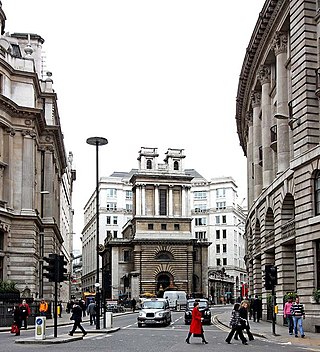
Lombard Street is a street notable for its connections with the City of London's merchant, banking and insurance industries, stretching back to medieval times.
Pasqua Rosée was a 17th-century servant who opened the first coffee-house in London and possibly Britain. He was born into the ethnic Greek community of the Republic of Ragusa. In 1651 he became the servant of Daniel Edwards, an English merchant of the Levant Company who was living in Smyrna in the Ottoman Empire; Rosée's duties included preparing and serving Edwards's daily coffee.
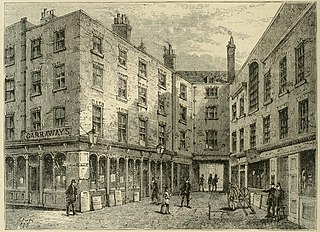
Garraways Coffee House was a London coffee house in Exchange Alley from the period where such houses served as important places where other business was performed. Its original proprietor, Thomas Garway, was already said to be the first person in England to sell tea prior to the house's founding, and when he began to sell it here in 1657 it became the first place in England to do so. The Hudson's Bay Company conducted its first sale of furs at the coffee house in 1671.
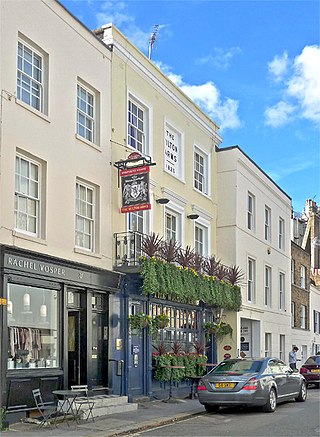
The Wilton Arms is a Grade II listed public house located in Kinnerton Street, Belgravia, London and built in 1825–26.

The East India Arms is a pub in the City of London. The building is located on Fenchurch Street near the place where the East India Company had its headquarters.
Countries have cultivated coffee beans into various vehicles to satisfy needs unique to each country. Whether it be for energy, socialization, or tradition, the cultivation of coffee has served as a motivating force of the world. The modernization of coffee and its unique forms across cultures are markers of tradition and modern changes across continents. Coffee culture appears in the way in which people consume coffee, the way they make it, and where coffee is served and shared. Each of these factors combined reflects the lives of the people in these countries and the importance of coffee across the world.

